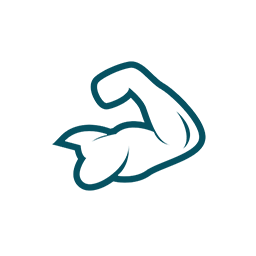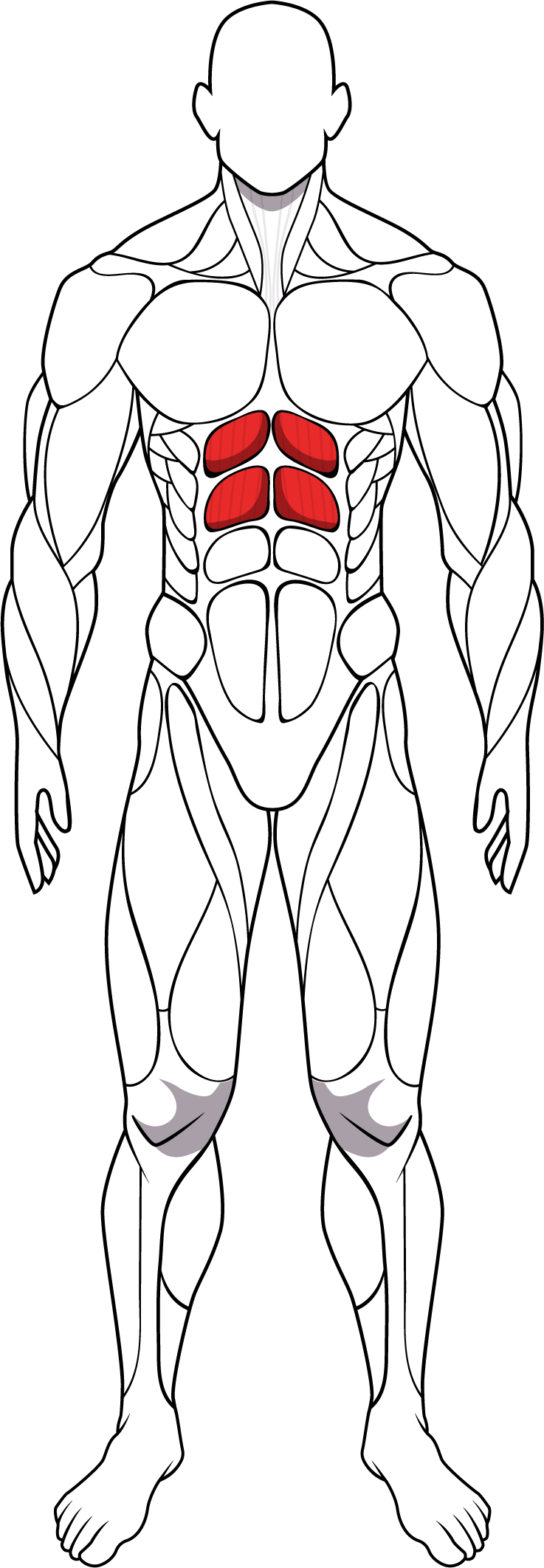The "abs," short for abdominal muscles, are a group of muscles located in the front and sides of the torso. They play a crucial role in stabilizing the spine, supporting posture, and facilitating various movements of the trunk. The abdominal muscles are divided into several distinct muscles, each with its own function and anatomical location:
The "abs," short for abdominal muscles, are a group of muscles located in the front and sides of the torso. They play a crucial role in stabilizing the spine, supporting posture, and facilitating various movements of the trunk. The abdominal muscles are divided into several distinct muscles, each with its own function and anatomical location:
Rectus Abdominis: The rectus abdominis is a long, flat muscle that extends vertically along the front of the abdomen. It is commonly referred to as the "six-pack" muscle due to its segmented appearance in individuals with low body fat. The rectus abdominis originates from the pubic symphysis (a joint at the front of the pelvis) and the pubic crest (a ridge on the pelvis) and inserts into the cartilage of the fifth, sixth, and seventh ribs, as well as the xiphoid process of the sternum (breastbone). The primary function of the rectus abdominis is to flex the spine, bringing the ribcage closer to the pelvis, as in crunching movements.
External Obliques: The external obliques are located on the sides of the abdomen, forming the outermost layer of the abdominal wall. They originate from the lower eight ribs and insert into the iliac crest (the top ridge of the pelvis), linea alba (a fibrous band that runs down the midline of the abdomen), and the inguinal ligament (a band of connective tissue in the groin). The external obliques play a significant role in trunk rotation and lateral flexion (bending sideways).
Internal Obliques: The internal obliques are situated beneath the external obliques, forming the intermediate layer of the abdominal wall. They have a similar fiber orientation to the external obliques but run in the opposite direction. The internal obliques originate from the inguinal ligament, iliac crest, and thoracolumbar fascia (a sheet of connective tissue in the lower back) and insert into the lower three ribs and the linea alba. Like the external obliques, the internal obliques contribute to trunk rotation and lateral flexion, as well as assisting in forced expiration (exhalation).
Transversus Abdominis: The transversus abdominis is the deepest layer of the abdominal muscles and plays a crucial role in providing stability and support to the spine and pelvis. It has a horizontal fiber orientation and runs across the abdomen like a corset. The transversus abdominis originates from the lower six ribs, thoracolumbar fascia, and iliac crest and inserts into the linea alba and pubic crest. Unlike the other abdominal muscles, the transversus abdominis does not contribute significantly to spinal movement but instead functions primarily in compressing the abdominal contents and stabilizing the trunk during movement and exercise.
In addition to these primary muscles, there are other smaller muscles and connective tissues in the abdomen that contribute to core stability and function. These include the diaphragm (a dome-shaped muscle involved in breathing), the pelvic floor muscles (which support the organs of the pelvis), and various fascial layers that provide structural support to the abdomen.
Strengthening the abdominal muscles is important for improving core stability, posture, and overall functional movement. Exercises that target the abs include:
Crunches: Crunches involve lying on the back with the knees bent and feet flat on the floor, then contracting the abdominal muscles to lift the shoulder blades off the floor.
Planks: Planks are performed by assuming a push-up position with the body in a straight line from head to heels, supporting the weight on the forearms and toes while engaging the core muscles to maintain stability.
Russian Twists: Russian twists are performed sitting on the floor with the knees bent and feet elevated, then rotating the torso from side to side while holding a weight or medicine ball.
Leg Raises: Leg raises involve lying on the back and lifting the legs upward toward the ceiling while keeping the lower back pressed into the floor, engaging the lower abdominal muscles.
Bicycle Crunches: Bicycle crunches are performed lying on the back with the knees bent and feet off the floor, then bringing one elbow toward the opposite knee while extending the other leg, alternating sides in a pedaling motion.
Incorporating a variety of abdominal exercises into your workout routine can help target all areas of the abs and promote overall core strength and stability. As with any exercise program, it's essential to perform movements with proper form and technique to maximize effectiveness and minimize the risk of injury. If you're new to strength training or have any concerns, consider working with a qualified fitness professional to develop a safe and effective workout plan tailored to your goals and fitness level.
Rectus Abdominis: The rectus abdominis is a long, flat muscle that extends vertically along the front of the abdomen. It is commonly referred to as the "six-pack" muscle due to its segmented appearance in individuals with low body fat. The rectus abdominis originates from the pubic symphysis (a joint at the front of the pelvis) and the pubic crest (a ridge on the pelvis) and inserts into the cartilage of the fifth, sixth, and seventh ribs, as well as the xiphoid process of the sternum (breastbone). The primary function of the rectus abdominis is to flex the spine, bringing the ribcage closer to the pelvis, as in crunching movements.
External Obliques: The external obliques are located on the sides of the abdomen, forming the outermost layer of the abdominal wall. They originate from the lower eight ribs and insert into the iliac crest (the top ridge of the pelvis), linea alba (a fibrous band that runs down the midline of the abdomen), and the inguinal ligament (a band of connective tissue in the groin). The external obliques play a significant role in trunk rotation and lateral flexion (bending sideways).
Internal Obliques: The internal obliques are situated beneath the external obliques, forming the intermediate layer of the abdominal wall. They have a similar fiber orientation to the external obliques but run in the opposite direction. The internal obliques originate from the inguinal ligament, iliac crest, and thoracolumbar fascia (a sheet of connective tissue in the lower back) and insert into the lower three ribs and the linea alba. Like the external obliques, the internal obliques contribute to trunk rotation and lateral flexion, as well as assisting in forced expiration (exhalation).
Transversus Abdominis: The transversus abdominis is the deepest layer of the abdominal muscles and plays a crucial role in providing stability and support to the spine and pelvis. It has a horizontal fiber orientation and runs across the abdomen like a corset. The transversus abdominis originates from the lower six ribs, thoracolumbar fascia, and iliac crest and inserts into the linea alba and pubic crest. Unlike the other abdominal muscles, the transversus abdominis does not contribute significantly to spinal movement but instead functions primarily in compressing the abdominal contents and stabilizing the trunk during movement and exercise.
In addition to these primary muscles, there are other smaller muscles and connective tissues in the abdomen that contribute to core stability and function. These include the diaphragm (a dome-shaped muscle involved in breathing), the pelvic floor muscles (which support the organs of the pelvis), and various fascial layers that provide structural support to the abdomen.
Strengthening the abdominal muscles is important for improving core stability, posture, and overall functional movement. Exercises that target the abs include:
Crunches: Crunches involve lying on the back with the knees bent and feet flat on the floor, then contracting the abdominal muscles to lift the shoulder blades off the floor.
Planks: Planks are performed by assuming a push-up position with the body in a straight line from head to heels, supporting the weight on the forearms and toes while engaging the core muscles to maintain stability.
Russian Twists: Russian twists are performed sitting on the floor with the knees bent and feet elevated, then rotating the torso from side to side while holding a weight or medicine ball.
Leg Raises: Leg raises involve lying on the back and lifting the legs upward toward the ceiling while keeping the lower back pressed into the floor, engaging the lower abdominal muscles.
Bicycle Crunches: Bicycle crunches are performed lying on the back with the knees bent and feet off the floor, then bringing one elbow toward the opposite knee while extending the other leg, alternating sides in a pedaling motion.
Incorporating a variety of abdominal exercises into your workout routine can help target all areas of the abs and promote overall core strength and stability. As with any exercise program, it's essential to perform movements with proper form and technique to maximize effectiveness and minimize the risk of injury. If you're new to strength training or have any concerns, consider working with a qualified fitness professional to develop a safe and effective workout plan tailored to your goals and fitness level.


